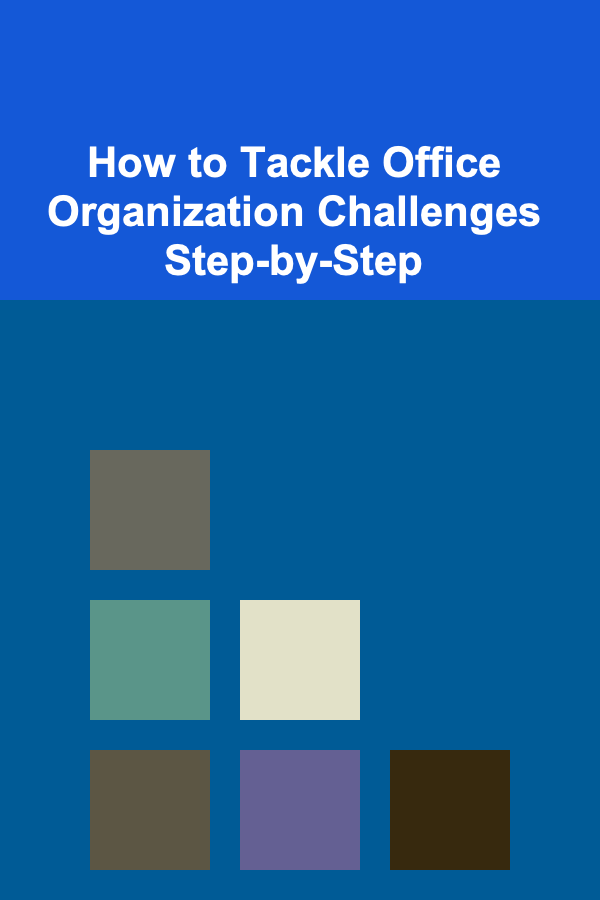
How to Tackle Office Organization Challenges Step-by-Step
ebook include PDF & Audio bundle (Micro Guide)
$12.99$8.99
Limited Time Offer! Order within the next:

In today's fast-paced work environment, effective office organization is vital for productivity and efficiency. However, many professionals face significant challenges when it comes to maintaining an organized workspace. This comprehensive guide will explore common office organization challenges and provide step-by-step strategies to overcome them.
Understanding the Importance of Office Organization
1. Enhanced Productivity
An organized office leads to improved focus and efficiency. Employees can find necessary items quickly, minimizing distractions and maximizing time spent on tasks.
2. Reduced Stress
A cluttered workspace can contribute to feelings of chaos and overwhelm. A well-organized environment fosters a sense of control and calm.
3. Improved Collaboration
An organized office facilitates smooth collaboration among team members. Shared spaces, documents, and resources are easier to access when everything is in its designated place.
4. Professional Appearance
An organized office reflects professionalism. It creates a positive impression on clients, visitors, and employees alike.
Recognizing the importance of office organization sets the stage for tackling related challenges.
Identifying Common Office Organization Challenges
Understanding specific challenges is essential for developing targeted solutions. Here are some common office organization issues:
1. Clutter and Disorganization
Physical clutter, including piles of paperwork or misplaced supplies, can lead to disorganization, making it difficult to locate needed items.
2. Inefficient Layout
An ineffective office layout can hinder movement and access to necessary tools, resulting in wasted time.
3. Poor Time Management
Time management plays a critical role in organization. Without effective planning, tasks may pile up, leading to rushed work and increased stress.
4. Lack of Systems and Processes
Many offices lack established systems for organizing documents, files, and tasks, contributing to confusion and inefficiency.
5. Resistance to Change
Employees may be resistant to new organizational methods, leading to inconsistent implementation and ongoing disorganization.
Identifying these challenges provides insight into the steps needed to improve office organization.
Step 1: Assess Your Current Workspace
Before implementing changes, it's crucial to evaluate your current workspace:
1. Conduct a Workspace Audit
Take time to observe your workspace. Identify areas that feel cluttered or chaotic. Pay attention to how you currently use your space and any pain points you encounter.
2. Note Frequently Used Items
Make a list of items or tools you use daily. Knowing what needs to be easily accessible will inform your organizational strategy.
3. Evaluate Storage Solutions
Examine existing storage options, such as cabinets, shelves, or filing systems. Determine if they meet your needs or require adjustments.
4. Gather Employee Feedback
If you're organizing a shared space, seek input from colleagues. Understanding their experiences and preferences can help create a more functional environment.
This assessment lays the groundwork for effective organization by providing insights into current practices and challenges.
Step 2: Define Your Organizational Goals
Setting clear goals is a crucial step toward effective office organization:
1. Identify Specific Objectives
Consider what you hope to achieve through improved organization. Common objectives might include:
- Reducing clutter by a certain percentage
- Creating designated areas for specific tasks
- Streamlining document retrieval processes
2. Consider User Needs
Tailor your goals to accommodate the needs of users within the space. Some people may prioritize ease of access, while others may focus on aesthetics.
3. Set Measurable Targets
Establish quantifiable targets to assess progress. For example, aim to reduce the time spent searching for documents by a specific amount.
Clearly defined goals serve as a roadmap for your organizational efforts.
Step 3: Develop an Organizational Plan
With goals in place, it's time to create a detailed plan for organizing your workspace:
1. Creating a Layout
a. Spatial Design
Determine how you want to arrange your workspace. Consider factors like traffic flow, accessibility to supplies, and collaborative areas.
b. Zoning
Create zones for specific functions (e.g., workstations, meeting areas, storage). Clearly defined zones help minimize distractions and promote focus.
2. Choosing Organizational Tools
a. Filing Systems
Invest in filing cabinets, labeled folders, or digital file management systems to streamline document storage and retrieval.
b. Storage Solutions
Utilize shelving, bins, or drawer organizers to keep supplies neatly arranged. Choose tools that suit the size and layout of your workspace.
c. Digital Tools
Consider integrating digital tools for task management and collaboration. Software like Trello or Asana can enhance organization and communication.
Developing a comprehensive plan ensures that all aspects of office organization are considered and addressed.
Step 4: Implement Your Plan
Execution is key to transforming your organized vision into reality:
1. Decluttering
a. Sort and Purge
Begin by sorting through items in your workspace. Assess each item's usefulness and relevance. Keep only what you need and remove outdated or unnecessary items.
b. Donate or Recycle
For items still in good condition but no longer needed, consider donating or recycling. This reduces waste and contributes to sustainability.
c. Dispose of Unnecessary Items
Safely dispose of items that cannot be reused, such as broken furniture or expired materials.
2. Organizing and Categorizing
a. Categorize Items
Group similar items together (e.g., writing instruments, office supplies, documents). This promotes easy access and reduces clutter.
b. Label Everything
Labeling helps make organization intuitive. Clearly mark folders, bins, and drawers to ensure everyone knows where to find items.
c. Create a Document Management System
If applicable, implement a digital document management system. Organize files into folders, using clear naming conventions to facilitate searchability.
Implementing your plan with thorough decluttering and careful categorization transforms your workspace into an organized environment.
Step 5: Maintain Your Organized Space
Once your workspace is organized, establishing maintenance routines is critical:
1. Set Regular Check-Ins
Schedule periodic evaluations of your organized space. Monthly check-ins can help identify any areas that may need reorganization.
2. Encourage Daily Clean-Up
Promote a culture of daily tidiness among employees. Encourage everyone to take a few minutes at the end of each day to return items to their designated places.
3. Adjust as Needed
Be open to adjusting your organizational methods based on feedback and changing needs. Flexibility allows your system to evolve over time.
4. Celebrate Successes
Recognize achievements related to organization. Celebrating milestones encourages continued commitment to maintaining an organized workspace.
Maintaining an organized space requires consistent effort, but it pays off in terms of productivity and clarity.
Step 6: Adapt and Evolve
Finally, be prepared to adapt your approach as needs change:
1. Stay Informed
Keep abreast of new tools and techniques that could enhance office organization. Attend workshops, read articles, or network with peers for fresh ideas.
2. Be Open to Change
Encourage a culture of adaptability among team members. Emphasize that organization is an ongoing process rather than a one-time event.
3. Solicit Continuous Feedback
Regularly gather feedback from employees about the effectiveness of your organizational systems. Use this information to make informed decisions about necessary changes.
4. Review Goals Periodically
Reassess your organizational goals at regular intervals. Ensure they align with current work demands and employee needs.
Being adaptable ensures that your office remains organized in the face of changing circumstances.
Conclusion
Tackling office organization challenges requires a thoughtful, step-by-step approach. By understanding the importance of organization, assessing your current workspace, defining clear goals, and developing a detailed plan, you can create a productive and efficient office environment.
Implementing your plan through decluttering, organizing, and categorizing will transform your space, while ongoing maintenance and adaptability will sustain those efforts over the long term.
By embracing effective office organization practices, you not only enhance productivity but also foster a positive work culture that benefits everyone involved. Start today, and take the necessary steps to create an organized and thriving workspace!
Reading More From Our Other Websites
- [Organization Tip 101] How to Use Color Coordination for Closet Organization
- [Organization Tip 101] How to Store Rare or Specialty Essential Oils
- [Personal Financial Planning 101] How to Maximize Your Employee Benefits for Financial Gain
- [Organization Tip 101] How Installing a Low-Flow Toilet Can Lower Your Utility Bills
- [Skydiving Tip 101] From Freefall to Philanthropy: Planning a Successful Charity Skydiving Event
- [Home Security 101] How to Secure Your Home on a Budget with Simple Tips
- [Home Storage Solution 101] How to Unlock Overhead Space: Maximizing Your Garage Ceiling Storage Potential
- [Home Maintenance 101] How to Choose the Right Contractor for Your Home Projects
- [Organization Tip 101] How to Create a Beautiful Entryway with Garden Design
- [Home Family Activity 101] How to Host a Family Card Games Tournament: Strategies, Variations, and Friendly Competition

How to Make Party Favors That Guests Will Love
Read More
How to Manage Tools for Raised Bed Gardening
Read More
How To Master Public Speaking for Introverts
Read More
How To Use Templates for Repetitive Tasks
Read More
How to Understand Theme and Symbolism in Fiction
Read More
Designing Custom Stickers and Decals for Print-on-Demand: A Comprehensive Guide
Read MoreOther Products

How to Make Party Favors That Guests Will Love
Read More
How to Manage Tools for Raised Bed Gardening
Read More
How To Master Public Speaking for Introverts
Read More
How To Use Templates for Repetitive Tasks
Read More
How to Understand Theme and Symbolism in Fiction
Read More